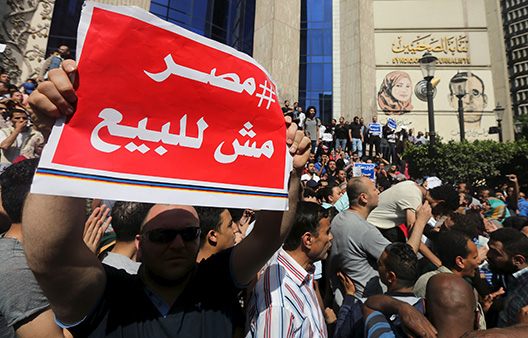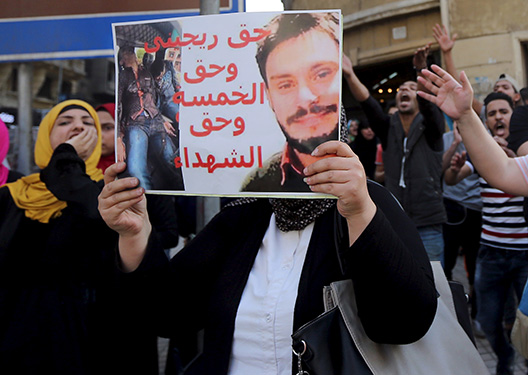 Thousands of protesters gathered in Cairo and elsewhere on April 15 to demonstrate against the transfer of two islands from Egyptian control to Saudi Arabia. They were the largest non-Islamist demonstrations since the forced removal of former president, Mohamed Morsi, in 2013 by the military. Then, as Defense Minister, Abdel Fattah al-Sisi was proclaimed as ‘savior’ by a large swathe of anti-Islamist opinion – today, among former supporters, he faces small but significant opposition over his presidency. The protests on Friday are not simply about the islands, however – and the response from the state remains interesting. The question is, what happens next?
Thousands of protesters gathered in Cairo and elsewhere on April 15 to demonstrate against the transfer of two islands from Egyptian control to Saudi Arabia. They were the largest non-Islamist demonstrations since the forced removal of former president, Mohamed Morsi, in 2013 by the military. Then, as Defense Minister, Abdel Fattah al-Sisi was proclaimed as ‘savior’ by a large swathe of anti-Islamist opinion – today, among former supporters, he faces small but significant opposition over his presidency. The protests on Friday are not simply about the islands, however – and the response from the state remains interesting. The question is, what happens next?
The status of the two islands is questionable. While the decision to transfer authority took Egyptians wholly by surprise, the assumption that the islands are actually Egyptian remains ambiguous. There are good legal grounds to consider the islands Egyptian, but there are also respectable claims on the Saudi side. The negotiations over these islands have been on-going for months and years now, so it is not as though the transfer happened out of the blue.
Of course, that’s not the point. As far as the Egyptian public is concerned, this is the first they have heard of the issue – and they have been presented with the decision almost as a fait accompli. The decision was announced during the visit of King Salman of Saudi Arabia to Egypt, and then subsequently defended by Sisi in front of a grouping of public figures. Once he had completed his statement, which received an immense amount of mockery on social media, someone present tried to speak – Sisi’s response was to shut him down, “I have not given anyone permission to speak.” It seems Friday was one response to that shutdown, where protesters had a slightly different twist on the famous January 25th revolutionary litany: “Bread, freedom – the islands are Egyptian!”
Egypt now has a parliament – an elected institution that admittedly received widespread criticism internationally for the restrictive and non-pluralistic nature of the elections that brought it into existence. Nevertheless, it exists, and on a matter such as the transferral of islands that were at least under Egyptian authority, if not definitely sovereignty, it was reasonable to assume a public consultation with parliament over the issue prior to the finalization of the agreement with Saudi. Instead, Sisi signaled that he didn’t want to countenance discussion around the issue at all after the fact, and that the Egyptian public should simply trust that the presidency and its supporters in the state apparatus were good patriots. Again, Friday seems to have been an answer to that.
The protests were significant, but perhaps for reasons that have little to do with numbers. For the first time since 2013, pro-Muslim Brotherhood protesters that were not associated with calling for the reinstatement of Mohamed Morsi, descended to the streets. The trigger was the issue of the islands – but the protests were not simply about them. That served only as a catalyst to declare about other issues, hence the January 25 slogans – and few if any partisan demands to call for the Islamist president’s return (which has been the subject of many other protests since 2013). That includes, crucially, the issue of police violence – the death of the Italian student, Giulio Regeni, widely suspected by swathes of the international and national press to be the result of police violence and torture, has brought that issue to forefront in a particular fashion.

An Egyptian activist holds a poster calling for justice to be done in the case of the recently murdered Italian student Giulio Regeni during the April 15 demonstration. (Reuters/Mohamed Abd El Ghany)
Different non-Brotherhood groups supported the protests on Friday – the Revolutionary Socialists, April 6, Strong Egypt, the Constitution Party – but they do not individually speak for large constituencies. They are small, and their base is fragmented – but the fact they protested at all is noteworthy. But will they be able to reach beyond their base, around a cohesive program of collective engagement, to apply pressure on the Egyptian government? That is less clear. On April 25, the protesters are scheduled to return, on the anniversary of the liberation of Sinai from Israeli control – a symbolic day to be sure.
Beyond that, however, is the question of how the state responded. Several thousand protesters were out on the April 15. The now outlawed Muslim Brotherhood had issued statement indicated they backed the protests – though if they were present, their supporters seem to have left their identifiable markers of the Raba’a four-fingered salute and pro-Morsi banners at home.
But the state didn’t characterize the protests as universally Brotherhood – and they didn’t take the opportunity to crackdown on the protests like a ton of bricks on April 15. Most Egyptian media largely ignored the protests, or downplayed them. For the first time in three years, a protest of several thousand people was able to form, and no lethal violence was used. If anyone died as the result of police violence, it was not reported. There was tear gas; there were unconfirmed reports of beatings – but no deaths. There were also some arrests during the protests – and many of those arrested were later released. The Ministry of Interior had declared a day before that the Brotherhood was at work to inspire ‘illegal protests’ – and arrested around twenty the day after the protests, with charges including the arranging of illegal protests. They have since been detained four days pending investigation. Had the security sector wanted to characterize the protests as ‘Muslim Brotherhood’ organized, it might have been able to do so – and any crackdown might have been passed with relatively little objection from the Egyptian press, which is universally opposed to the Brotherhood.
Compared to other protests and confrontations with the police by demonstrators, where civilians died in the midst of violence and far more arrests took place, these, protests went off relatively without too much of a hitch, were dispersed by the protesters themselves around sunset, with them resolving to return ten days later.
Nationalist feeling around the islands is probably more widespread than the authorities assume – not at the level of intensity that would lead massive numbers to descend to the streets; but perhaps widespread enough that the security sector found it difficult to use extreme force against the protesters. Indeed, it is entirely plausible that within the fragmented establishment (the ‘non-regime’) there is a great deal of dissent against at least the handling of the islands’ issue, if not the transferring of authority over them altogether. Within parliament, some MPs supported the government, while others opposed; the broader media showed the same.
The state continues to be, nonetheless, more cohesive than the even more fragmented opposition to the state. In 2011, protesters were able to capitalize on dissent against authority, and dissent within authority – the army establishment eventually turned on then president Hosni Mubarak. In 2016, the state establishment is uninterested in the departure of the president – and Sisi still has a significant proportion of the population that supports him. There is no immediate threat to his presidency that might see his departure – but the April 15 protests are still striking. The economic situation in Egypt continues to deteriorate, and that, combined with frustration with the lack of reform within the security sector and elsewhere may lead to more protests going forward. But neither protests, nor the current set of state policies, are sustainable ideas for going forward. The clash seems set to continue – but in a country that has often proven unpredictable in the past.
Dr. H.A. Hellyer is a Nonresident Senior Fellow at the Rafik Hariri Center for the Middle East at the Atlantic Council. He is also Associate Fellow in International Security Studies at the Royal United Services Institute (RUSI) in London.
Image: An Egyptian activist holds a sign that reads "Egypt is not for sale" during a demonstration protesting the government's decision to transfer two Red Sea islands to Saudi Arabia, in front of the Press Syndicate in Cairo, Egypt, April 15, 2016. (Reuters/Mohamed Abd El Ghany)
